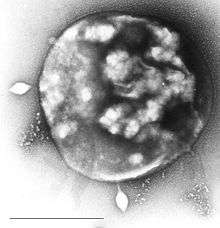Proteoarchaeota
| Proteoarchaeota | |
|---|---|
 | |
| Archaea Sulfolobus infected with specific virus STSV-1. | |
| Scientific classification | |
| Domain: | Archaea |
| Kingdom: | Proteoarchaeota Petitjean et al. 2014 |
| Phyla | |
Proteoarchaeota are a proposed archaeal kingdom.
Classification
The phylogenetic relationship of this group is still under discussion. The relationship of the members is approximately as follows:[1][2][3]
| Proteoarchaeota |
| |||||||||||||||||||||||||||||||||||||||||||||||||||||||||
Further reading
- Petitjean, C.; Deschamps, P.; López-García, P.; Moreira, D. (2014). "Rooting the Domain archaea by phylogenomic analysis supports the foundation of the new kingdom proteoarchaeota". Genome Biol. Evol. 7 (1): 191–204. PMC 4316627
 . PMID 25527841. doi:10.1093/gbe/evu274.
. PMID 25527841. doi:10.1093/gbe/evu274. - Eugene V. Koonin (2015). "Archaeal ancestors of eukaryotes: not so elusive any more". BMC Biology. 13 (1): 84. PMC 4594999
 . PMID 26437773. doi:10.1186/s12915-015-0194-5.
. PMID 26437773. doi:10.1186/s12915-015-0194-5.
- ↑ Anja Spang et al. 2015. Complex archaea that bridge the gap between prokaryotes and eukaryotes. Nature 521, 173–179 (14 May 2015) doi:10.1038/nature14447
- ↑ Katarzyna Zaremba-Niedzwiedzka et al. 2016-2017, Asgard archaea illuminate the origin of eukaryotic cellular complexity. Nature 541, 353–358 (19 January 2017) doi:10.1038/nature21031
- ↑ Patrick Forterre, Morgan Gaïa: Giant viruses and the origin of modern eukaryotes, in: Current Opinion in Microbiology 31, June 2016, 44-49, DOI: 10.1016/j.mib.2016.02.001
This article is issued from
Wikipedia.
The text is licensed under Creative Commons - Attribution - Sharealike.
Additional terms may apply for the media files.